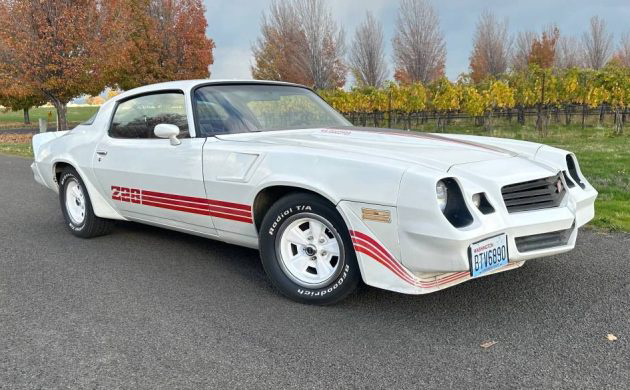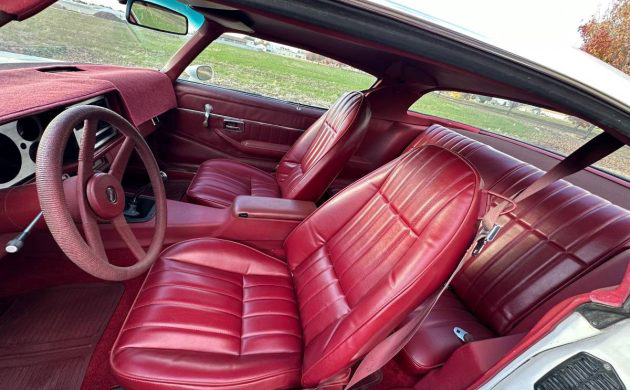While many enthusiasts aspire to own a pristine classic, there is something undeniably attractive about owning a tidy driver. Those cars offer a relaxed motoring experience because the owner doesn’t face the stress of an errant stone marring perfection during a weekend jaunt. That may cause some to give this 1980 Camaro Z28 more than a passing glance. The seller admits it has dings and chips, but it retains most of its original paint, and the buyer can enjoy this gem immediately. The desirable drivetrain combination adds to its appeal, making this the most potent Z28 that money could buy in 1980. It is ready to find a new home, with the seller listing the Camaro here on Craigslist in Walla Walla, Washington. They set their price at $17,900, and I must say a big thank you to Barn Finder T.J. for spotting this genuine survivor.
Chevrolet adopted a “business as usual” approach with its Camaro range in 1980. A replacement for the Second Generation was waiting in the wings, and cosmetic changes were limited to a few minor tweaks on the Z28. The seller describes this Camaro as a survivor, admitting its Code 11 White paint has accumulated chips and scratches, while the panels sport minor bumps and bruises. There are no significant issues, and the car’s rust-free status means that preservation is viable, and a cosmetic restoration could happen at the new owner’s leisure. A close inspection reveals the front clip and hood received a repaint at some point, and the front bumper has a couple of minor flaws. The car retains its correct spoilers and fender flares in good condition, but the distinctive graphics show signs of age. The glass is crystal clear, and the color-matched wheels are remarkably clean for their age.
The “tidy survivor” theme continues inside this Camaro, with the Sanyo radio/cassette player and dash cover the only visible aftermarket additions. The cover conceals a cracked dashpad, and it is unclear whether the new owner might be able to perform a satisfactory repair with a product like Polyvance. If all else fails, replacement pads retail for around $400. The Carmine Red vinyl is generally in good order, with problems seemingly limited to a few small lifting areas on the door trims. The seats look excellent, the carpet is above average, and the console hasn’t succumbed to age. It isn’t loaded with factory options, although the new owner will undoubtedly welcome the air conditioning if they live in a warm location.
American high-performance cars were generally shadows of their former selves as the 1980s dawned. The Camaro Z28 was no exception, and this car was the most potent a buyer could order in 1980. It features a 350ci V8, a four-speed manual transmission, and power assistance for the steering and brakes. The small-block produces 190hp and 280 ft/lbs of torque, allowing the Z28 to cover the ¼-mile in 16.1 seconds. Some younger enthusiasts who didn’t live through The Malaise Era question how profound the impact of tighter emission regulations was on performance models, and this Camaro answers that question. The small-block in a 1970 Z28 churned out 360hp and 380 ft/lbs, and the ¼-mile ET was a mere 13.9 seconds. The difference is staggering, although the fact the 1980 model carried an additional 180 lbs didn’t help its cause. The seller indicates this classic is in excellent mechanical health. They recently replaced the battery, water pump, and thermostat and performed an oil change. It retains its original exhaust, which is quite an accomplishment for a forty-four-year-old car. The drivetrain leaves a few oil drops if left for a few days, but the engine doesn’t burn oil. The Z28 runs and drives perfectly and is a turnkey proposition for its new owner.
I always admire a restored classic, especially when the owner focuses on the finer details to achieve perfection. Those cars undoubtedly turn heads and will invariably receive respect and favorable comments. However, survivors like this 1980 Camaro Z28 command respect for a different reason. Knowledgeable enthusiasts recognize that they have been driven and enjoyed as their creators intended, not squirreled away in a garage. Enjoyment is what the classic ownership experience should be about, which is what this Z28 seems to promise. That makes it worth a closer look.







Its also worth mentioning to the younger generation that how they rated horsepower between 1970 and 1980 were dramatically different. Of course the 1970 350cid was much more powerful, but that 360hp rating would have been more like 270hp by NET standards. Gross hp ratings were done without exhaust, accessories like power brakes and steering, AC etc
I wouldn’t mind the dings and chips whatsoever with this beauty. My particular quest would include new hinges for those notoriously heavy and huge doors while subtly reinforcing the hard points where those hinges attach. That would be it for a while.
It was common to see those side dents and chipped paint when these Camaros were new. No side protection whatsoever.
Even though it took away from the looks a bit, I decided to order the side moldings and roof drip rails.
I do recall the Camaros of the day as not having a roof drip molding. As an aside, there was one design for a roll-formed wheel opening molding that dated to 1955 or so. I once had the opportunity to see the original blueprint for the molding. It had a bright bead which is what was seen on the car with a long return flange that would be pierced for screw holes so it could attached to the inside opening of the wheel housing. This single design was used on many of GM’s vehicles and we rolled various lengths of these continuously. They’d go to a bender to be fabricated, pierced and then be sent to our anodizing plater.
Very nice example at a good price.
Good looking Z/28 with decent equipment. Air induction and a 4-speed. The red graphics don’t jump off the white paint for me. Maybe gold or gray would have more impact.
Do you remember the roof drip moldings? Were yours aftermarket? The GM Fisher Body plant where I worked had PVC extrusion lines which made the body-side moldings. I can’t recall the extrusion profile offhand but I believe that your moldings would have had silver mylar trim on each side with PVC down the middle. The roof drip moldings could have been stick-on PVC extrusion too that would have channeled any water rearward. My job location was tangential to the extrusion lines (30 or so in a long line) so I got to see some of the process.
From what I can recall, they had a chrome trim on the edges, and seemed to be made of metal that was spot welded on the edge of the roof, just above the windows.
I’m not even sure that you could get the drip rails or the side moldings on the Z/28 as I can’t recall ever seeing one with them. They take away from the sporty look.
What a beauty! 4speed, No T-tops, too bad the 85mph Speedo ruins the whole vibe. Wonder how hard to swap in a 130 mph version from an earlier year?
Thank Joan Claybrook for the speedo. I hated these in my cars as well. She actually thought it would make you drive slower.
The only thing that made me drive slower in those days was Nixon after he hit us over the head with the double nickel, he gave local cop shops big block grants to enforce it. Suddenly, there were expensive speed traps everywhere. The insurance companies and little towns laughed all the way to the bank. We all know that speed, when applied responsibly is safe, far safrer then a distracted or drunk driver. But, the cop hiding behind a billboard eating donuts and gulping RC Cola doesn’t see that. They need to blend in with the traffic and see what is going on, but that makes no money, but would be safer for everyone on the road.
When I was younger, back in the dark ages of the early 80’s, a family friend had this exact car. Same paint color, same interior, same engine and transmission. He would take us out in the boonies of southwestern Pennsylvania for joy rides in the summer, and to a 10 year old boy that car sure did feel fast and it took the turns pretty well for the time. I loved watching the cowl induction hood open up when he floored it. I think $17k is a little steep for a malaise era “muscle” car, but if I bought it the first thing I’d do is ditch all the smog equipment, install an aluminum intake and better carb along with long tube headers and free flowing exhaust. Then some aluminum heads with bigger valves and higher compression and then just enjoy driving it on sunny days.
You can’t enjoy it on sunny days just the way it is? Only stock once, ya know.
All of that work and expense would make very little improvement without upgrading the camshaft.
Just install new bushings.
More like 12 to 14k. Would b realistic.
Late 80, early 81 maybe, I was 18 and worked in the old Nationwide auto.
a kid younger than me started working with us at the store, and he had one of these with the 4speed. Fun car to drive, he would let me take it on bank runs, as he was fascinated with my X1/9.